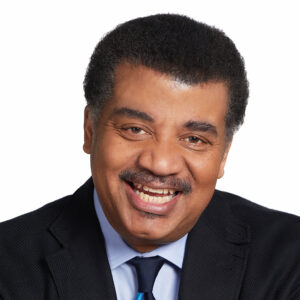About This Episode
What’s up with the fourth dimension? Can anything travel faster than light? Neil deGrasse Tyson and Chuck Nice explore things you thought you knew about dimensions, tachyons, and isotopes.
Learn about time and space and how we navigate through both. What would a 2D world be like for two-dimensional people? We break down what it’s like for 3D beings to interact with the second dimension and what it would be like for 4D beings to interact with the third dimension. Plus, we discuss flying cars and whether we already have them.
Can anything travel faster than light? We explain what a tachyon is and how it could travel faster than the speed of light. What happens when you go faster than the speed of light? What are the different ways to move faster than light? We break down a tachyon’s relationship to time, Cherenkov radiation, and how the early universe expanded faster than the speed of light.
What is an isotope? Neil deGrasse Tyson breaks down isotopes– like carbon-14, deuterium, and helium-3– and the variations that exist in the periodic table of elements. What happens when you add a neutron? We break down what is going on in the nucleus of atoms as well as go over common isotopes. What is “heavy water”? Learn about deuterium, tritium, isotopes of helium, and carbon-14. How do we use carbon-14 dating to find out the age of an object?
Thanks to our Patrons John Amneus, Eric, LUC THEO 280, Alex Mata, Katik, David Drain, Gwen Blake, Claira Broach, Keenan Smout, Zack Dagle, Ted, Julie Garisto, Trevor Whitfield, Lax Starkie, Bored as It, Vic Carnage, Martin Reavis, Tim Racine, Jodi Raffoul, Steve Wolf, Kimberly Dossett, Tyrell Blaylock, Samantha Lus, Daniel, odie wrex, Dakota Riffee, Joe Cutler, Odessa Rose, Nathan, Ang, A vat of K, Charles Boudreau, Zachery Hunter, Ashanti Abdullah, Madelaine Tully, Rocío, Becky Ziegler, Monty Thorstenson, Suresh, Ryan Pacharzynski, Andrew Pierce, Shervin Koramdel, Tim, Brandon Hughes, JJ M, lou, Moe Fury, Eric Max, Bren Plummer, Tyler Scott, Tom Davies, Marilyn Rivera, Jeff Nesmith, June504760, Colin Montoute, Billie Williams, and Jason Hamilton for supporting us this week.
NOTE: StarTalk+ Patrons can listen to this entire episode commercial-free.




 Unlock with Patreon
Unlock with Patreon

 Become a Patron
Become a Patron